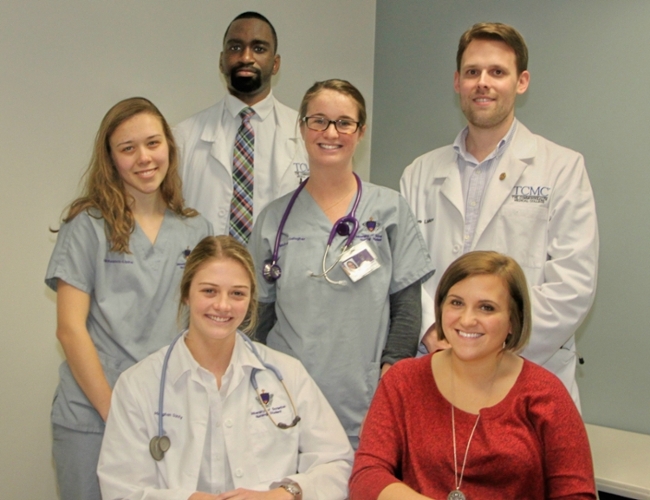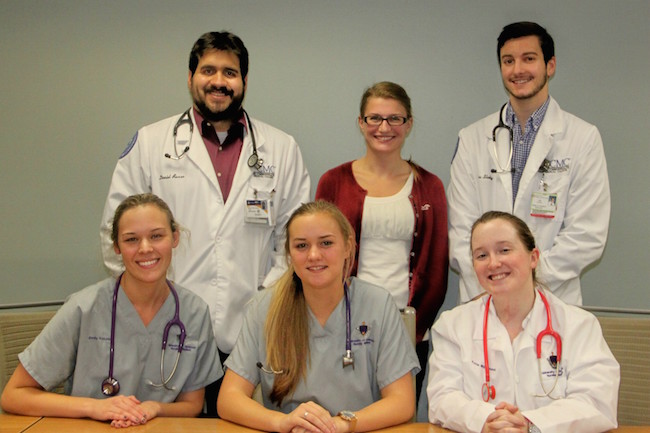Scranton Teams with TCMC and Marywood for Interprofessional Training Simulation

Nursing students at The University of Scranton, social-work graduate students at Marywood University and medical students at TCMC participated in an interprofessional simulation using SimMan, an advanced patient simulator. Seated from left: Meaghan Ginty, junior majoring in nursing, The University of Scranton, and Michelle Ostroski, graduate student, Marywood University, School of Social Work. Standing are Kaitlin Reznick-Lipina, senior majoring in nursing, The University of Scranton; Nelsen Sofoluke, third-year medical student, TCMC; Michaela Gallagher, senior majoring in nursing, The University of Scranton; and Steven Liskov, third-year medical student, TCMC.

More than 240 students from The University of Scranton, Marywood University and TCMC participated in an interprofessional simulation on the campuses of TCMC and Scranton. Seated from left: Emily Kotchick, senior majoring in nursing, The University of Scranton; Kelly Boyle, senior majoring in nursing, The University of Scranton; and Katherine Williamson, junior majoring in nursing, The University of Scranton. Standing: Daniel Russo, third-year medical student, TCMC; Kaitlyn Klemick, graduate student, Marywood University, School of Social Work; and Alex Slaby, third-year medical student, TCMC.
If you want to rattle some future nurses, put them in a small room with some future doctors and a future social worker or two they’ve never met. Send in a teenage patient in severe asthmatic distress. Then add the patient’s frantic mother and the students’ faculty members to carefully observe every move.
Simply put, “It’s nerve-racking,” Danae Snyder, a senior nursing student from Clarks Summit, said of the interprofessional education exercise designed to teach teamwork and communication to nursing students at The University of Scranton, social-work students at Marywood University and medical students at The Commonwealth Medical College (TCMC).
Fortunately, the stressful exercise was only a dramatization, starring SimMan, an advanced patient simulator, and an actor hired by TCMC to play the worried mother.
Margarete Zalon, Ph.D., University of Scranton nursing professor, was among the organizers of the exercise involving more than 240 students from the three institutions. “This year, we went bigger and better than last year, which was no small feat,” she said.
Last year, half of the junior and half of the senior nursing class were involved. “This year we decided we would include all our juniors and seniors,” she said.
The high-fidelity simulation, which permits an escalating situation, was presented in 48 sessions over three days. Half took place at the University and half at TCMC. Twenty-nine faculty members from the University and TCMC were involved in observing the sessions and conducting the debriefings afterward.
The scenario, which had to be programmed into the simulator, was written by Deborah Zielinski, the University’s laboratory director, and Colleen Heckman, assistant laboratory director. The laboratory staff, including University alumna and instructor Laura Skoronski, was charged with running the simulators. The lab staff also programed the mannequin to respond to student interventions.
The circumstances were the same ones presented to students last year in the cooperative project with TCMC. The staff considered the fact that some of this year’s students also would have participated last year, Dr. Zalon said. “But a year changes things.” Even repeat students, she said, would be working with new people whom they had not previously met, and that is always a challenge, especially in an emergency.
Cooperation across fields also was a key point of the simulation, Dr. Zalon said.
Interprofessional educational opportunities are “very limited in the course of students’ regular experiences,” she said, explaining the value of having nursing, medical and social work students problem-solve together.
One “challenge” was the patient’s mother. The actor, well-trained to panic, accomplished her job of throwing some students off their game.
“It was difficult to focus while she was freaking out,” said Dana Addesa, a junior nursing student from Old Forge, quickly noting the actor’s important role in teaching the importance of on-the-spot problem solving.
Her team decided a social worker should calm her, but “we all agreed a nurse should have gone over to her as well,” Addesa said.
Snyder said her team also found the mother challenging.
“You have to be able to look at each other and give each other cues,” she said, explaining how nonverbal communication was an important lesson here as well.
Dr. Zalon confirmed the mother’s panic and outbursts were all part of the plan.
SIM-Man, though not real, also gets into his role, Snyder said. “He even started to sweat.” Students had to take SIM-Man’s blood-pressure reading and check his heart rate and respiration, and “the whole time the patient was talking to us,” she said.
In turn, they had to talk to each other and eventually take the case to the doctor.
“We had to communicate with the doctor, and this was good to practice doing that,” Snyder said. “In our situation, the patient wasn’t getting any better. It’s about learning when to call the doctor.”
Watching the decision-making unfold was important for the faculty observers, who would then take the students into a conference room for a debriefing.
“That’s where the learning takes place,” Dr. Zalon said.
Addesa and Snyder agreed the exercise, as intended, drove home the importance of communication.






